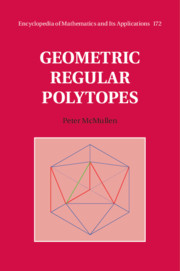Book contents
- Frontmatter
- Contents
- Foreword
- I Regular Polytopes
- 1 Euclidean Space
- 2 Abstract Regular Polytopes
- 3 Realizations of Symmetric Sets
- 4 Realizations of Polytopes
- 5 Operations and Constructions
- 6 Rigidity
- II Polytopes of Full Rank
- III Polytopes of Nearly Full Rank
- IV Miscellaneous Polytopes
- Afterword
- Bibliography
- Notation Index
- Author Index
- Subject Index
3 - Realizations of Symmetric Sets
from I - Regular Polytopes
Published online by Cambridge University Press: 30 January 2020
- Frontmatter
- Contents
- Foreword
- I Regular Polytopes
- 1 Euclidean Space
- 2 Abstract Regular Polytopes
- 3 Realizations of Symmetric Sets
- 4 Realizations of Polytopes
- 5 Operations and Constructions
- 6 Rigidity
- II Polytopes of Full Rank
- III Polytopes of Nearly Full Rank
- IV Miscellaneous Polytopes
- Afterword
- Bibliography
- Notation Index
- Author Index
- Subject Index
Summary
The bridging concept between the abstract and geometric is the theory of realizations. This chapter concentrates on symmetric sets, namely, finite sets on which a group of permutations acts transitively. After a discussion of their basic properties, the concept of their realizations is introduced, with operations on them (such as blending) showing that the family of their congruences classes has the structure of a convex cone. A key idea is that of the inner product and cosine vectors of realizations, which define them up to congruence. The theory up to this point is then illustrated by some examples. It is next shown that, corresponding to the tensor product of representations, there is a product of realizations. Another fundamental notion is that of orthogonality relations for cosine vectors. The different realizations derived from an irreducible representation of the abstract group may form a subcone of the realization cone that is more than 1-dimensional. These are looked at more closely, leading to a definition of cosine matrices for the general realization domain. There follows a discussion of cuts and their relationship with duality. Cosine vectors may have entries in some subfield of the real numbers, with implications for the corresponding realizations. The chapter ends with a brief account of how representations of groups are related to realizations.
Keywords
- Type
- Chapter
- Information
- Geometric Regular Polytopes , pp. 94 - 138Publisher: Cambridge University PressPrint publication year: 2020

